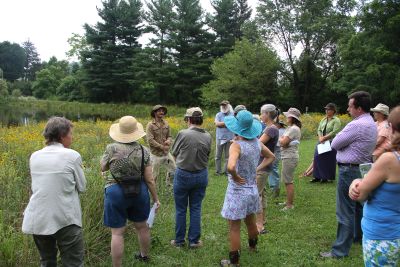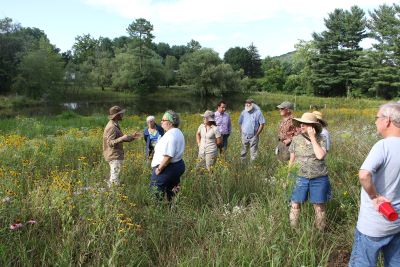How Healthy Are Our Watersheds?
Ways to Protect Our Watersheds
Stream Buffers
-Riparian Buffer & Rain Garden
-Buffer Handbook
-Sources of native plants
Upper Thornton River Watershed Study
RappFLOW is a member of the Orion Grassroots Network
Avon Hall Pond Project
(most recent documents or articles first)
July 15, 2015 - Sam Quinn, field biologist from the Farm at Sunnyside, explains the native plant species growing in the pond buffer meadow on a field walk. Donna Marquisee and Janet Davis taught about the native plants in the wetlands. Photo credit: Forrest Marquisee.


Field Walk of Native Plants Buffer
 July 15, 2015, at 5 p.m. at Avon Hall Pond in Town of Washington
July 15, 2015, at 5 p.m. at Avon Hall Pond in Town of Washington
With Field Biologist Sam Quinn from the Farm at Sunnyside; Donna Marquisee and Janet S. Davis, Native Plant Gardeners; Marc Malik, Landscape Architect
Learn why, when and how to make your pond healthier and more beautiful.
Habitat Projects Sponsored by Rappahannock Friends and Lovers of Our Watersheds, Old Rag Master Naturalists, the Town of Washington, Culpeper Soil & Water Conservation District, and VA Dept of Forestry
Questions? Contact beverly@bevhunter.com
*************
Invitation!
Come and see how the buffer grasses and flowers are doing so far this spring!
On Saturday June 20, 2015, from 5 to 7 pm, RappFLOW volunteers will lead walking tours of the buffer area of the Avon Hall pond, in association with the Old Rag Master Naturalists and the CCLC party at Avon Hall.
Photos at Avon Hall, Spring 2015
"Pond News is Good News" - Rappahannock News article about Avon Hall presentation in October 2014
Avon Hall Pond Watershed and Habitat Project Status Report September 2014; Presented to Town Council by RappFLOW (PDF)
- Town Council of Washington, Virginia September 15, 2014 Briefing on Avon Hall (outline) (PDF)
- Contributors to Avon Hall Pond Restoration and Habitat Project in 2014 (PDF)
- E coli colonies per 100 ml in Avon Hall pond, fall 2013 - September 2014 (PDF)
- RappFLOW educational activities related to Avon Hall Pond in 2013 – 2014 (PDF)
Soil test reports from Virginia Tech Soil Testing Lab
To view Soil Test Notes referred to in report comments and
listed in the "See Notes" box on the upper right of the report, go to: http://www.soiltest.vt.edu/Files/publications.html
Soil Test Note #1 - Explanation of Soil Tests applies to all reports.
Summary of Plantings 2013 - 2014 (latest 7/24/14)
People and Pollinators Enjoy Town Habitats (June 2014)
Plan of Work April - September 2014
2014 Proposal to Virginia Trees for Clean Water
Washington nature trail takes shape
Avon Hall Pond Project Brochure, March 2014
Student Interns Participate in Project
- Helen Hutcheson
- Ben Estes
Combined Avon Hall Pond Plan 2013 (PDF)
Town Pond Project Meeting with CSWCD Jan. 22, 2013
Plan for Avon Hall pond watershed improvement -- field session Dec. 17, 2012, with Lou Verner (PDF)
[Summary] RappFLOW joins heads with The Virginia Department of Game and Inland Fisheries' Lou Verner on Monday, December 17, 2013, to assess the health of the Avon Hall Pond in Little Washington, Virginia. An expert on ponds and wetlands, Lou Verner will give us his professional opinion on what we can do to bring the Avon Hall Pond back to life. We have laid the groundwork for a project to restore the health of the pond, and Lou is going to help fill in any gaps, and advise us on the best way to achieve our plan of action.
Recommendations for Enhancing Avon Hall Pond (2008)
From BJ Valentine, USGS (posted 3/30/2013)
Here is a report generated from the online NRCS web soil survey website that outlines the soils mapped around Avon Hall. Included in the report is an estimation of acreage, which just calculates the area of every map unit in a giving area of interest. Just a note that soil surveys should not be used for small site-specific purposes, but the soil scientist who completed Rappahannock's survey did a very detailed job.
The survey shows two map units in and around Avon Hall that are very promising if you want to grow wetland vegetation. Worsham is considered a hydric soil, which means it is capable of supporting hydrophytic vegetation, and the map unit Meadowville under the right conditions (i.e. poor soil structure, landscape position) could have a watertable within 20 inches of the surface (See Hydric Soil Section of report). And with the pond holding water fairly well I would say all in all you have good conditions to support the proposed buffer.
This is probably more information than you would like but it might help in the future. If you have further soil questions just let me know.
